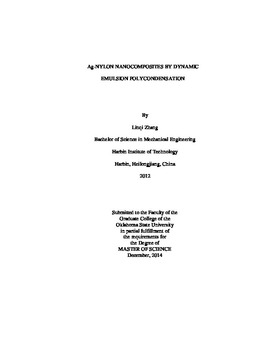| dc.contributor.advisor | Kalkan, Ali K. | |
| dc.contributor.author | Zhang, Linqi | |
| dc.date.accessioned | 2016-01-20T15:45:12Z | |
| dc.date.available | 2016-01-20T15:45:12Z | |
| dc.date.issued | 2014-12-01 | |
| dc.identifier.uri | https://hdl.handle.net/11244/25742 | |
| dc.description.abstract | Thermoplastics (plastics) have revolutionized human life due to their low cost and ease of fabrication. A common and effective approach to mechanical enforcement of thermoplastics is inclusion of micro- or nanofillers of higher strength and elastic modulus. Conventionally, the fillers are dispersed by shear mixing in molten polymer, where viscosity of the mixture is dramatically increased due to large interface area. Accordingly, the dispersion is not efficient and filler content is typically limited to below 5% by weight. The present thesis work develops a novel technique for dispersing nanofillers in a thermoplastic polymer where polycondensation and dispersion of the nanofillers occur simultaneously via dynamic emulsion polycondensation at ambient temperature. The composite is manufactured in the form of a uniform powder, which can be molded into desired shape by melting.The technique is demonstrated for silver nanowire - Nylon 66 nanocomposites. In this demonstration, silver nanowires are synthesized by polyol process. Polyvinylprrolidone (PVP) is used to functionalize the silver nanowires. Composites with silver weight fraction of 1.49%, 3.28%, 6.74% are prepared and characterized by SEM, TEM, UV-Vis, Raman, FTIR, DSC and nano-indentation. The silver nanowires are found to be monodispersed and hydrogen-bonded to the Nylon 66 matrix through PVP. Glass transition temperature of the composites decreases from 61 to 48 with silver weight fraction increasing from 0 to 6.47%. The decrease of the glass transition temperature is owed to the plasticizer effect as well as heterogenous nucleation effect of the nanowires for polymerization leading to shorter chain length. Finally, mechanical properties of the composites show insignificant variation with the filler content. This absence of the composite effect is explained by Halpin-Tsai model, where the filler enforcement and decrease in matrix modulus counterbalance. | |
| dc.format | application/pdf | |
| dc.language | en_US | |
| dc.publisher | Oklahoma State University | |
| dc.rights | Copyright is held by the author who has granted the Oklahoma State University Library the non-exclusive right to share this material in its institutional repository. Contact Digital Library Services at lib-dls@okstate.edu or 405-744-9161 for the permission policy on the use, reproduction or distribution of this material. | |
| dc.title | Ag-Nylon Nanocomposites by Dynamic Emulsion Polycondensation | |
| dc.type | text | |
| dc.contributor.committeeMember | Harimkar, Sandip P. | |
| dc.contributor.committeeMember | Materer, Nicholas F. | |
| osu.filename | Zhang_okstate_0664M_13770.pdf | |
| osu.accesstype | Open Access | |
| dc.description.department | Mechanical & Aerospace Engineering | |
| dc.type.genre | Thesis | |
